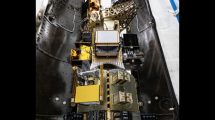![]() Space Development Agency has selected L3Harris Technologies and Northrop Grumman to each build 14 missile-tracking satellites for a low Earth orbit constellation known as the Tracking Layer.
Space Development Agency has selected L3Harris Technologies and Northrop Grumman to each build 14 missile-tracking satellites for a low Earth orbit constellation known as the Tracking Layer.
L3Harris won a $700m contract and Northrop Grumman a $617m deal for the Space Development Agency’s Tracking Layer Tranche 1.
L3Harris Technologies will serve as “eyes in the sky” detecting, identifying and tracking advanced missile threats. It will build a 14-vehicle satellite constellation that will include optical communications terminals, infrared mission payloads, Ka-band communications payloads and multiple pointing modes – advanced technology specifically designed to identify and track the fastest missiles known to exist. The programme also includes related ground, operations and sustainment support.
L3Harris developed four prototype satellites under the SDA’s Tracking Layer Tranche 0 award in 2020. The four space vehicles produced under the $193m firm fixed-price contract will launch in 2023.
Meanwhile, Northrop Grumman will build and deploy a proliferated low-Earth orbit constellation of 14 satellites with infrared sensors for the SDA Tranche 1 Tracking Layer (T1TRK).
T1TRK will detect, identify and track hypersonic weapons and other advanced missiles from their earliest stages of launch through interception. Northrop Grumman will leverage its experience with the Tranche 1 Transport Layer (T1TL), to provide a resilient, low-latency, high-volume network in space to support US military missions around the world.
Once deployed in 2025, the T1TRK satellites will operate in up to four low-Earth orbital planes, interconnected with T1TL satellites. Each will feature a wide field-of-view infrared sensor, three optical communications terminals, and a Ka-band payload for communications.
Commenting on the contract, Christopher E. Kubasik, Chair and Chief Executive Officer, said: “Investing in resilient space assets and acting as a Trusted Disruptor in this market are core to our long-term strategy. Our customers have been clear; missile defence technology and space domain awareness architecture must be diversified, and our teams are positioned to deliver those cutting-edge solutions.”
Derek Tournear, Director of SDA, added: “Flowing from our values as an organization prioritizing schedule, then cost, the Tranche 1 Tracking Layer went from solicitation to award in approximately 120 days and continues to demonstrate the Space Development Agency’s ability to acquire capabilities at speed. We look forward to collaborating with our industry partners to quickly deliver missile warning/missile tracking capabilities as part of the Department of Defense hybrid architecture that will provide critical and timely information to the joint warfighter in the very near future.”
Kelle Wendling, President of Space Systems, L3Harris, stated: “L3Harris is successfully executing SDA’s foundational Tracking Layer Tranche 0 programme, which set their strategic way forward for rapidly deploying relevant mission capabilities to our nation’s warfighters. This Tranche 1 win demonstrates our ability to nimbly scale from initial demonstration to proliferation with enhanced mission capability, resilience, global coverage, and speed to deployment as threats continue to evolve.”
Robert Fleming, Northrop’s Vice President and General Manager of the Strategic Space Systems Division, commented: “Northrop Grumman will provide an integrated space vehicle that will accelerate our nation’s ability to defend against the most pressing challenges in missile defence. T1TRK builds upon Northrop Grumman’s experience with T1TL and will demonstrate a capability to track advanced missile threats.”












Add Comment